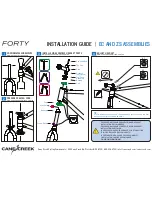
16
2.12 Set the handlebars
The handlebars on your trike adjust forward and back, as well as for width. Sit on the trike and adjust the bars
to a position that feels comfortable. Typically, the angle of your elbow joint should be slightly more than 90
degrees open. Check the clearance between your hands and the wheels; also check the clearance between
the brake levers and frame at full steering lock. Adjusting the handlebars to their widest comfortable position
that doesn't interfere with the front wheels will give you the maximum amount of steering movement. Tighten
the handlebar clamps.
Do not use the handlebars to pull yourself out of the trike with; they are
not meant for this purpose. Under normal use the handlebars will not
slip in their clamps, they will however move if subjected to an abnormal
force.
There is also no need to pull on the handlebars when riding. The trike is
easily steered with a light grip of the fingers.
2.13 Set the front boom
With the seat angle and handlebars set, determine the boom position by sitting on the trike and placing your
heel
on the pedal. Adjust the boom so that your leg is straight when the pedal is at its furthest away from you.
Set the front boom upright (by eye), and then tighten the 2 clamp bolts.
Check the boom is not
extended past its MIN
INSERT mark.
If in doubt about the
length, set the boom a little
longer than you think may
be required; it will be
easier to shorten the chain
later. Try pedaling without
the chain on to see if it
feels about right.











































